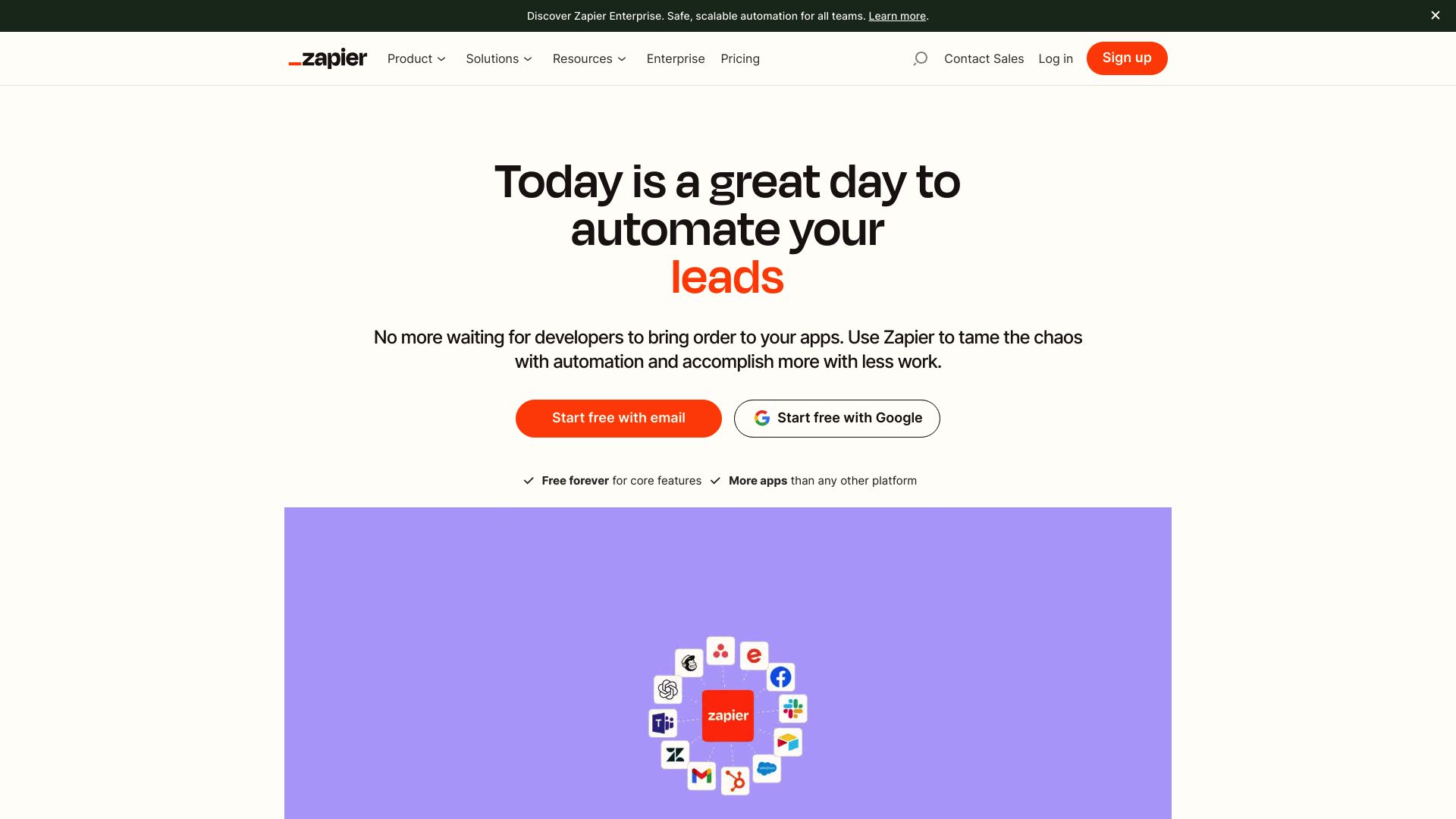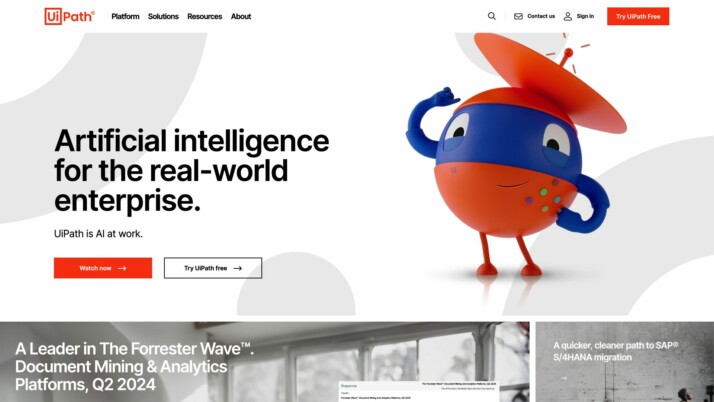Zapier vs. UiPath: AI Automation Showdown for 2024
The AI automation landscape offers powerful tools to streamline workflows and boost productivity. This comparison explores Zapier’s user-friendly app integrations, UiPath’s robust enterprise automation, and SmythOS’s cutting-edge AI capabilities. We examine how each platform tackles automation challenges, from simple task connections to complex process orchestration.
By dissecting core features, security measures, and target use cases, this review equips you to choose the ideal automation solution for your needs. Whether you’re a small business owner seeking efficiency or an enterprise leader aiming for digital transformation, understanding these platforms’ strengths and limitations is crucial in today’s AI-driven world.
Zapier Overview
Zapier streamlines business processes by connecting over 6,000 apps through automated workflows called Zaps. This platform empowers users to create integrations between web applications, APIs, and services without writing code.


Zapier’s visual builder enables users to construct multi-step workflows connecting disparate apps. Triggers watch for data changes in one application, automatically initiating actions in another. This functionality proves invaluable for tasks like syncing customer data across platforms or automating marketing campaigns.
Zapier streamlines business processes by connecting over 6,000 apps through automated workflows called Zaps.
The platform caters to both non-technical users and developers. Its no-code interface allows anyone to build integrations, while the Zapier CLI offers advanced customization options for those with programming skills. This flexibility makes Zapier suitable for small businesses and large enterprises alike.
Zapier’s extensive app library covers major SaaS platforms like G Suite, Slack, and Salesforce. However, it lacks built-in AI agent capabilities or natural language processing features. While excellent for app integrations, Zapier is not designed for building conversational AI or complex autonomous systems.
Scalability and security features, such as team collaboration tools and OAuth support, make Zapier a robust choice for growing businesses. However, users seeking advanced AI functionalities or multi-modal interactions may find the platform’s capabilities limited in these areas.
UiPath Overview
UiPath powers enterprise automation, enabling organizations to streamline operations through intelligent software robots. The platform combines robotic process automation (RPA) with artificial intelligence to automate repetitive tasks and complex workflows across diverse business functions.


At its core, UiPath offers an end-to-end automation suite covering process discovery, development, management, and analytics. The Studio visual designer allows both technical and non-technical users to build automations using drag-and-drop functionality and pre-built activity libraries. For deployment and orchestration, UiPath Orchestrator provides centralized robot management, scheduling, monitoring, and analytics capabilities.
UiPath excels in enterprise-grade scalability and governance features critical for large organizations. The platform seamlessly integrates with existing IT infrastructure…
UiPath excels in enterprise-grade scalability and governance features critical for large organizations. The platform seamlessly integrates with existing IT infrastructure and supports both attended and unattended automation scenarios. This flexibility enables automation of front-office tasks requiring human input as well as fully autonomous back-office processes.
While UiPath delivers powerful automation capabilities, it requires significant investment in licensing, infrastructure, and training to maximize value. The complexity of enterprise-wide deployment and maintenance can pose challenges for smaller organizations or those new to RPA. Additionally, UiPath focuses primarily on structured process automation rather than general AI problem-solving or natural language interactions.
UiPath continues expanding its offerings through acquisitions and partnerships to address emerging automation needs. Recent additions include process mining, task mining, and AI capabilities to enhance the platform’s intelligent automation potential. As RPA adoption grows, UiPath aims to solidify its position as a comprehensive digital workforce platform for the modern enterprise.
Feature Comparison
Zapier and UiPath offer distinct approaches to automation, with key differences in their core components and security features. Zapier excels in connecting web applications and APIs through its extensive library of pre-built integrations, allowing users to create automated workflows without coding. Its visual builder and no-code interface make it accessible to non-technical users. However, Zapier lacks built-in AI agent capabilities and advanced features like hosted vector databases or multimodal interactions.
UiPath, on the other hand, focuses on robotic process automation (RPA) with a more comprehensive enterprise-grade platform. It provides tools for process discovery, development, and orchestration of software robots. UiPath offers stronger capabilities for complex, end-to-end process automation within organizations. Unlike Zapier, UiPath includes features for attended and unattended automation scenarios, making it suitable for both front-office and back-office tasks. However, UiPath’s enterprise focus comes with a steeper learning curve and higher implementation costs compared to Zapier’s more straightforward approach.
In terms of security, both platforms offer basic features like data encryption and OAuth support. However, UiPath’s enterprise orientation means it provides more robust security and governance features critical for large organizations. Zapier’s security features, while sufficient for many users, may not meet the stringent requirements of highly regulated industries or complex enterprise environments.
Feature Comparison Table
| Zapier | UiPath | SmythOS | |
|---|---|---|---|
| CORE FEATURES | |||
| AI Agents | ❌ | ❌ | ✅ |
| Hosted Agents (Dev, Production) | ❌ | ❌ | ✅ |
| No-Code Options | ✅ | ❌ | ✅ |
| Memory & Context | ❌ | ❌ | ✅ |
| Autonomous Agents | ❌ | ❌ | ✅ |
| Explainability & Transparency | ❌ | ❌ | ✅ |
| Multimodal | ❌ | ❌ | ✅ |
| Problem-Solving Capabilities | ❌ | ❌ | ✅ |
| Multi-Agent Collaboration | ❌ | ❌ | ✅ |
| Human-AI Interaction | ❌ | ✅ | ✅ |
| Work as Team | ✅ | ❌ | ✅ |
| Agent Work Scheduler | ❌ | ✅ | ✅ |
| SECURITY | |||
| Constrained Alignment | ❌ | ❌ | ✅ |
| IP Control | ❌ | ✅ | ✅ |
| COMPONENTS | |||
| Foundation AIs | ❌ | ❌ | ✅ |
| Huggingface AIs | ❌ | ❌ | ✅ |
| Zapier APIs | ✅ | ❌ | ✅ |
| Classifiers | ❌ | ❌ | ✅ |
| Logic | ❌ | ✅ | ✅ |
| Data Lakes | ❌ | ❌ | ✅ |
| DEPLOYMENT OPTIONS (EMBODIMENTS) | |||
| Deploy as API | ✅ | ❌ | ✅ |
| Deploy as Webhook | ✅ | ❌ | ✅ |
| Staging Domains | ✅ | ❌ | ✅ |
| Production Domains | ✅ | ❌ | ✅ |
| Deploy as Site Chat | ❌ | ❌ | ✅ |
| Deploy as Scheduled Agent | ❌ | ❌ | ✅ |
| Deploy as GPT | ❌ | ❌ | ✅ |
| DATA LAKE SUPPORT | |||
| Hosted Vector Database | ❌ | ❌ | ✅ |
| Sitemap Crawler | ❌ | ❌ | ✅ |
| YouTube Transcript Crawler | ❌ | ❌ | ✅ |
| URL Crawler | ❌ | ❌ | ✅ |
| PDF Support | ❌ | ✅ | ✅ |
| Word File Support | ❌ | ✅ | ✅ |
| TXT File Support | ❌ | ❌ | ✅ |
Best Alternative to Zapier and UiPath
SmythOS emerges as the superior alternative to Zapier and UiPath, offering a comprehensive AI automation platform that combines the best of both worlds. Our platform excels in creating and deploying intelligent AI agents, surpassing the capabilities of traditional automation tools.
Unlike Zapier’s focus on simple web app integrations or UiPath’s emphasis on robotic process automation, SmythOS provides a versatile ecosystem for building sophisticated AI-powered workflows. We offer an intuitive drag-and-drop interface that enables users to create complex AI agents without extensive coding knowledge, making advanced automation accessible to a broader audience.
SmythOS stands out with its robust AI capabilities, including support for multiple AI models, natural language processing, and machine learning integration.
SmythOS stands out with its robust AI capabilities, including support for multiple AI models, natural language processing, and machine learning integration. This allows for the development of intelligent agents capable of understanding context, learning from interactions, and making decisions autonomously—features absent in both Zapier and UiPath.
Our platform’s flexibility shines through its diverse deployment options. Users can implement SmythOS agents as APIs, webhooks, scheduled tasks, or even chatbots, providing unparalleled versatility compared to the limited deployment options of Zapier and UiPath. This adaptability ensures that SmythOS can seamlessly integrate into existing workflows and systems across various industries and use cases.
With SmythOS, we’ve eliminated the constraints found in Zapier and UiPath. Our platform offers advanced features like hosted vector databases, multimodal interactions, and support for various data formats, enabling users to tackle complex automation challenges that extend far beyond simple task automation or RPA. By choosing SmythOS, businesses gain a powerful tool that not only automates processes but also enhances decision-making and drives innovation through intelligent AI agents.
Conclusion
Zapier and UiPath each offer unique strengths in the automation landscape. Zapier excels at connecting web applications through its extensive integration library and user-friendly interface, making it ideal for small to medium businesses seeking straightforward workflow automation. UiPath, with its robust RPA capabilities and enterprise-grade features, caters to large organizations requiring complex, end-to-end process automation.
However, SmythOS emerges as the superior choice, combining the best of both worlds while adding powerful AI capabilities. Our platform’s drag-and-drop interface rivals Zapier’s ease of use, while our extensive integration ecosystem of over 300,000 connections surpasses both competitors. Unlike Zapier and UiPath, SmythOS offers built-in AI agent capabilities, enabling users to create intelligent, autonomous workflows that can handle complex tasks and decision-making.
SmythOS stands out with its ’Create Once, Deploy Anywhere’ approach, allowing users to deploy AI agents across various platforms seamlessly. This flexibility, combined with our support for multiple AI models and multimodal interactions, positions SmythOS as the most versatile and powerful automation platform available. For businesses looking to harness the full potential of AI-driven automation, we invite you to explore our diverse range of AI-powered agent templates and create a free SmythOS account to experience the future of workforce automation firsthand.
Last updated:
Disclaimer: The information presented in this article is for general informational purposes only and is provided as is. While we strive to keep the content up-to-date and accurate, we make no representations or warranties of any kind, express or implied, about the completeness, accuracy, reliability, suitability, or availability of the information contained in this article.
Any reliance you place on such information is strictly at your own risk. We reserve the right to make additions, deletions, or modifications to the contents of this article at any time without prior notice.
In no event will we be liable for any loss or damage including without limitation, indirect or consequential loss or damage, or any loss or damage whatsoever arising from loss of data, profits, or any other loss not specified herein arising out of, or in connection with, the use of this article.
Despite our best efforts, this article may contain oversights, errors, or omissions. If you notice any inaccuracies or have concerns about the content, please report them through our content feedback form. Your input helps us maintain the quality and reliability of our information.
